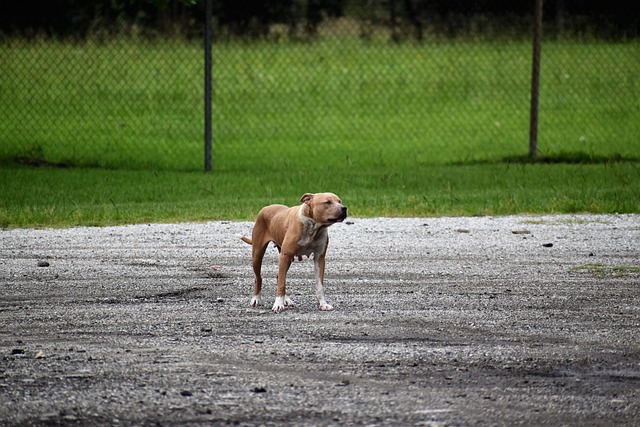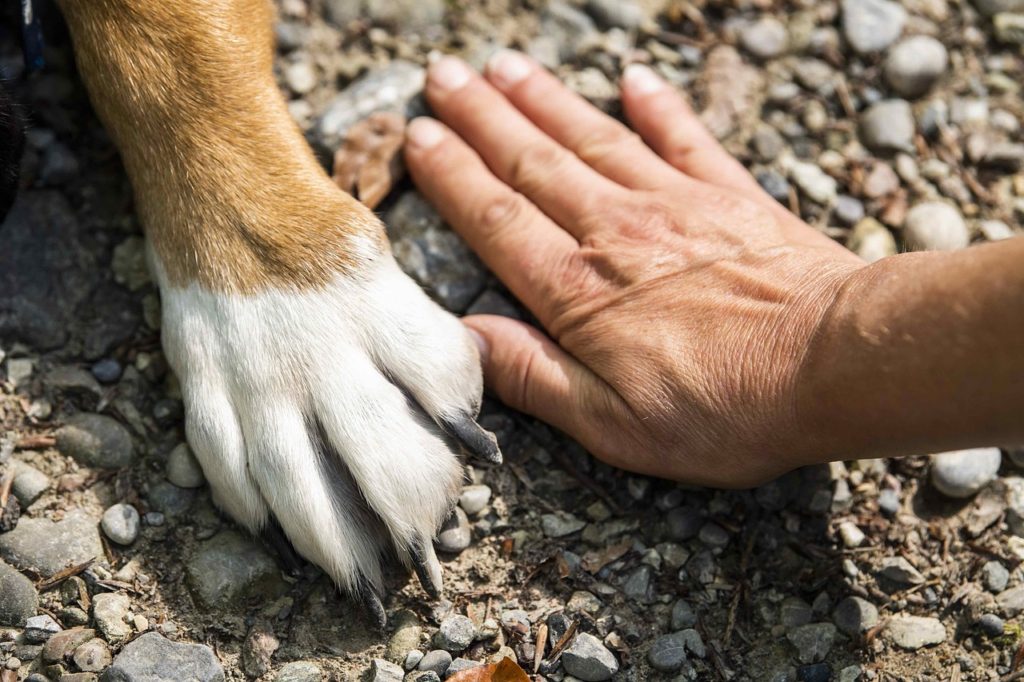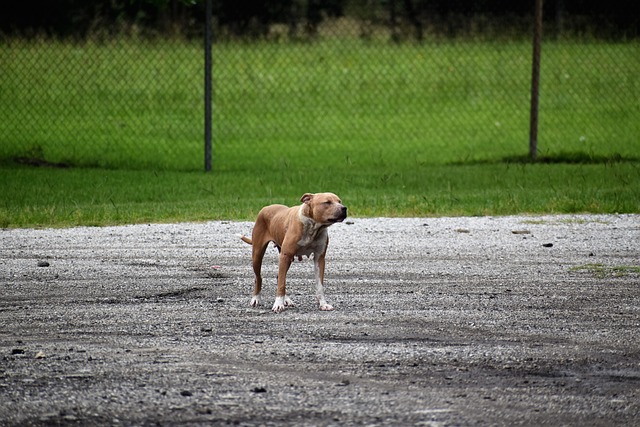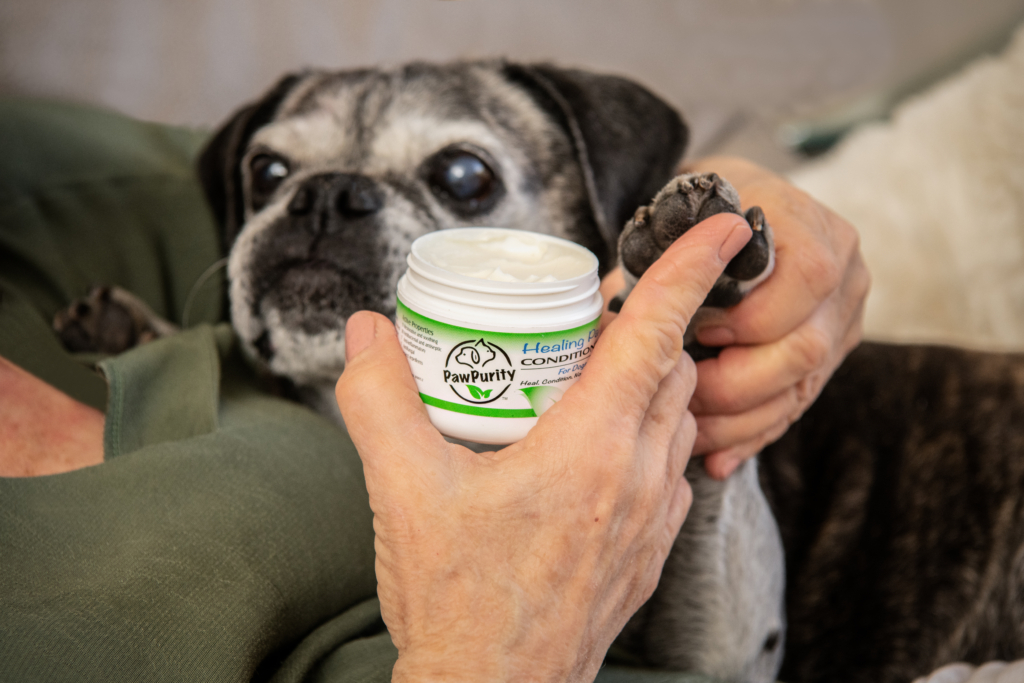Protect Your Dog’s Paws
Our furry family member’s well-being, and one often overlooked area is the paws. Protecting dog paw pads in summer heat is serious. These unique and sensitive parts of a dog’s body play a vital role in their overall health and mobility. Let’s delve into the importance of how to care for a dog’s paw pads, what temperatures are safe for walking, the dangers of extreme temperatures, the effects of hot surfaces, and how to care for dog paw pads in general.
The Dangers of Summer’s Extreme Temperatures
Just like human skin, dog paw pads in summer are susceptible to temperature extremes. Extremely hot temperatures can cause significant damage to its paw pads, leading to pain, discomfort, and even serious injuries. As a general rule, if a surface is too hot for you to comfortably place the back of your hand on for more than five seconds, it is too hot for a dog to walk on. Taking walks early or at night after the temperatures have cooled is one way of protecting a dog’s paws in summer.
Effects of Hot Temperatures on Paw Pads
Walking on hot surfaces can result in painful burns and blisters on your dog’s paw pads. Even short exposure to hot pavement, sand, or asphalt can cause thermal burns and lead to the pads peeling, cracking, or drying out. Such injuries can cause immense pain and discomfort for pets and may require veterinary attention. Protecting dog paws in the summer heat is in the hands of the pet owner. If the dog is prancing about and looking for shade, immediately take the pooch indoors.
Injury Levels from Walking on Hot Surfaces
There are varying levels of injury that dogs can sustain from walking on hot surfaces. Initially, mild discomfort may be experienced, which can progress to redness and swelling. Prolonged exposure to hot surfaces can result in burns, blisters, and painful sores on the paws in summer. In severe cases, the skin may peel or slough off, exposing raw tissue and necessitating immediate veterinary care.
Maintaining Healthy Paw Pads in Summer Temperatures
Unhealthy paw pads can be breeding grounds for various infections, including fungal and bacterial infections. Additionally, cuts, abrasions, and cracks in the pads can occur, which not only cause pain but also increase the risk of infection. Keeping your dog’s paw pads healthy during extreme temperatures is crucial to its overall well-being and quality of life.
Safe and Dangerous Temperatures for Dogs to Walk On
It is crucial to be aware of safe and dangerous temperatures for your dog to walk on. While dogs can tolerate a range of temperatures, it’s best to err on the side of caution.
“If the temperature is 85 degrees or over without the chance for the pavement to cool down, the ground may be too hot for safely walking a dog,” says Dr. Klein. To find out if the ground is too hot for your dog to walk on, place your hand comfortably on the pavement for ten seconds. If it’s too hot for your hand, it’s too hot for your dog’s paws.”
DR. JERRY KLEIN, DVM, CHIEF VETERINARY OFFICER FOR THE AKC AND AN EXPERT IN VETERINARY EMERGENCY AND CRITICAL CARE
According to data reported by the Journal of the American Medical Association, when the air temperature is 86 degrees, the asphalt temperature registers 135 degrees. Below are approximate guidelines for SURFACE temperatures:
- Safe temperatures: Up to 100°F (37.8°C)
- Use caution: 100-125°F (37.8-51.7°C)
- Dangerous temperatures: Above 125°F (51.7°C)
Various Surfaces on Paw Pads in Summer
Different surfaces affect dog paw pads differently. Hot pavement or asphalt can retain heat and become scorching during warm weather, posing a significant risk of dog pad burns. Sandy surfaces, while generally cooler, can cause discomfort or irritation due to rough textures. Additionally, sharp rocks, gravel, or icy surfaces can cause abrasions or cuts. Regularly inspecting your dog’s paw pads and choosing appropriate surfaces for walks can help prevent injuries.
Infections and Injuries
One effective way to protect dog paw pads in summer is by using PawPurity Healing Paw Conditioner. This natural, non-toxic balm is specifically formulated to nourish, protect, and heal paw pads. It helps moisturize dry pads, soothe irritations, and promote healthy tissue regeneration. Regularly applying this conditioner can help maintain supple and healthy paw pads, reducing the risk of injuries and infections.
We also recommend your pet wear dog shoes during extreme heat. There are many dog shoe manufacturers and styles. One that stands out in particular is Wagwear, as they have a large selection. Make sure to read return policies before purchasing however. Protecting dog paw pads in summer is a priority in keeping your pooch happy and healthy.
Protecting Dog Paw Pads in Summer Heat
Protecting dog paw pads in the summer heat is essential to a dog’s overall health and well-being. By being mindful of extreme temperatures, and avoiding hot surfaces. Regular monitoring, proper hydration, and keeping the paws clean and conditioned will go a long way in preventing infections and injuries. Don’t forget to check out PawPurity Healing Paw Conditioner!
Dog Paw Health
Skin, Coat & Paw Care
Can Dog Paws Handle Snow?
by Lisa Porter
on Dec 04 2022
Dogs are known for being able to handle cold weather fairly well. Their fur coats protect them from cold temperatures and they enjoy running around in the snow. But what about their paws? Can dog paws handle snow? And if not, what can help them stay safe in the winter weather? In this blog post, we’ll look at some of the issues that can occur when dogs walk on snow and ice and provide tips for keeping your furry friend safe during the winter months.
Dog Health, Pet Health & Skin
Top-of-Paw Biting and Yeast
by Lisa Porter
on Jul 30 2023
One of the biggest concerns I’ve often heard from dog owners why dog biting top of paws happens. Dog owners what to know what it the cause and what can be done about it. While it can be due to various reasons, top of paw biting may be influenced by skin irritations caused by certain ingredients in dog shampoos. Let’s explore which ingredients in shampoos can be initiating this behavior, the benefits of natural ingredients over chemical-based shampoos. We will also explore other triggers that may cause this behavior.
Flea & Tick Protection, Skin, Coat & Paw Care
Essential Tips: What To Do For Injured Dog Pads
by Lisa Porter
on Dec 27 2022
Injured paw pads can cause immense pain and hamper your pet’s ability to walk, play and live a comfortable life. But the good news is that you don’t have to just stand by helplessly and watch – there are steps you can take towards proper management of dog pad injuries that can help bring some relief for your pup.


















